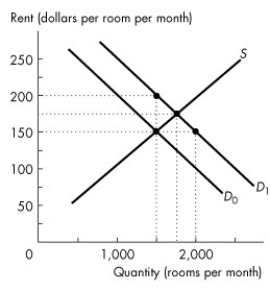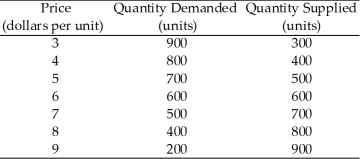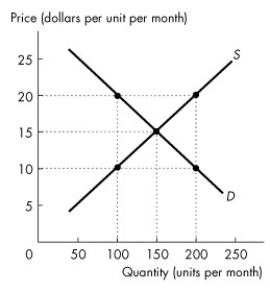A) results in a shortage of housing if the rent ceiling is below the equilibrium rent.
B) results in a surplus of housing if the rent ceiling is above the equilibrium rent.
C) always results in a shortage of housing.
D) always results in a surplus of housing.
E) Both A and B are correct.
Correct Answer

verified
Correct Answer
verified
Multiple Choice
In an unregulated housing market with no rent ceiling,
A) scarce housing resources are allocated inefficiently.
B) scarce housing resources are allocated efficiently.
C) tenants pay a lower rent compared to what they pay in a market with an effective rent ceiling.
D) landlords receive less compared to what they receive in a market with an effective rent ceiling.
E) consumer surplus equals producer surplus.
Correct Answer

verified
Correct Answer
verified
Multiple Choice
If the penalty on sellers of an illegal good is less than the penalty on buyers of an illegal good,then supply of the good will ________ by ________ demand and the price of the good will ________.
A) decrease;more than;rise
B) decrease;less than;rise
C) decrease;less than;fall
D) decrease;more than;fall
E) increase;less than;rise
Correct Answer

verified
Correct Answer
verified
Multiple Choice
The ________ principle is the proposition that people should pay taxes equal to the benefits they receive from the services provided by government. The ________ principle is the proposition that people should pay taxes according to how easily they can bear the burden of the tax.
A) benefits;ability-to-pay
B) equality;fairness
C) services;burden
D) ability-to-pay;benefits
E) efficient;inefficient
Correct Answer

verified
Correct Answer
verified
Multiple Choice
A production quota is set equal to the equilibrium quantity.At the quota quantity,marginal social benefit is ________ marginal social cost and the level of production is ________.
A) less than;efficient
B) greater than;efficient
C) less than;inefficient
D) equal to;efficient
Correct Answer

verified
Correct Answer
verified
Multiple Choice
Use the figure below to answer the following questions.
 Figure 6.3.2
-Refer to Figure 6.3.2.The seller's share of the tax is
Figure 6.3.2
-Refer to Figure 6.3.2.The seller's share of the tax is
A) zero.
B) $0.50.
C) $1.00.
D) $1.50.
E) $2.00.
Correct Answer

verified
Correct Answer
verified
Multiple Choice
A production quota
A) increases the marginal social cost of production.
B) lowers the price and increases the marginal social cost of production.
C) increases demand for the good.
D) raises the price and decreases the marginal social cost of production.
E) makes production more efficient.
Correct Answer

verified
Correct Answer
verified
Multiple Choice
Use the figure below to answer the following questions.
 Figure 6.1.1
-Refer to Figure 6.1.1.Suppose the demand for rental housing is shown by demand curve D?,and there is a rent ceiling of $150 per room.What is the highest rent that would be charged in a black market?
Figure 6.1.1
-Refer to Figure 6.1.1.Suppose the demand for rental housing is shown by demand curve D?,and there is a rent ceiling of $150 per room.What is the highest rent that would be charged in a black market?
A) $150 a month
B) $175 a month
C) $200 a month
D) $100 a month
E) cannot be determined from the graph, but we know it is greater than $200
Correct Answer

verified
Correct Answer
verified
Multiple Choice
An illegal market in which the equilibrium price exceeds the price ceiling is
A) a rental market.
B) a capital market.
C) a black market.
D) an efficient market.
E) a housing market.
Correct Answer

verified
Correct Answer
verified
Multiple Choice
Use the table below to answer the following questions.
Table 6.3.1
 -Refer to Table 6.3.1.Suppose a sales tax of $2 a unit is imposed on the good described in the table.Government revenue from the tax is
-Refer to Table 6.3.1.Suppose a sales tax of $2 a unit is imposed on the good described in the table.Government revenue from the tax is
A) $1,200.
B) $1,000.
C) $800.
D) $600.
E) zero.
Correct Answer

verified
Correct Answer
verified
Multiple Choice
A $10 per-unit tax on MP3 players raises the equilibrium price paid by consumers by $5.The quantity sold before the tax was 5,000 per year.The revenue from the tax is
A) zero.
B) positive but less than $50,000 per year.
C) $50,000 per year.
D) more than $50,000 per year.
E) greater the more elastic is demand.
Correct Answer

verified
Correct Answer
verified
Multiple Choice
In an unregulated housing market with no rent ceiling,the rent is determined by the
A) landlords only.
B) tenants only.
C) government only.
D) market.
E) landlords, tenants, and the government.
Correct Answer

verified
Correct Answer
verified
Multiple Choice
Use the figure below to answer the following questions.
 Figure 6.1.2
-Refer to Figure 6.1.2.What would be the maximum black market price of the good if a price ceiling is set at $10 a unit?
Figure 6.1.2
-Refer to Figure 6.1.2.What would be the maximum black market price of the good if a price ceiling is set at $10 a unit?
A) $10
B) $15
C) $20
D) 50 goods sold at $10 and 50 goods sold at $20
E) 50 goods sold at $10 and 50 goods sold at $15
Correct Answer

verified
Correct Answer
verified
Multiple Choice
An effective rent ceiling
A) increases producer surplus.
B) results in a producer surplus of zero.
C) sometimes increases producer surplus and sometimes decreases producer surplus.
D) decreases producer surplus.
E) decreases the supply of housing.
Correct Answer

verified
Correct Answer
verified
Multiple Choice
Use the table below to answer the following questions.
Table 6.2.1
 -Table 6.2.1 gives the supply and demand schedules for teenage labour in Genoa City.In an unregulated market,
-Table 6.2.1 gives the supply and demand schedules for teenage labour in Genoa City.In an unregulated market,
A) there is no teenage unemployment and the wage rate is $6 per hour.
B) there is no teenage unemployment and the wage rate is $5 per hour.
C) teenage unemployment is 400 hours and the wage rate is $6 per hour.
D) teenage unemployment is 400 hours and the wage rate is $5 per hour.
E) the minimum wage is $7 per hour.
Correct Answer

verified
Correct Answer
verified
Multiple Choice
All of the following statements about legalizing and taxing drugs are true except
A) legalizing and taxing drugs would eliminate the black market in drugs.
B) the quantity of a drug bought could be decreased if the drug was legalized and taxed.
C) a sufficiently high tax could be imposed to decrease supply, raise the price, and achieve the same decrease in the quantity bought as with a prohibition of drugs.
D) an extremely high tax rate would be needed to cut the quantity of drugs bought to the level prevailing with a prohibition.
E) tax revenue can be used to make law enforcement more effective.
Correct Answer

verified
Correct Answer
verified
Multiple Choice
If enforcement is aimed at buyers of an illegal good,the
A) price and quantity bought decrease.
B) price and quantity bought increase.
C) price rises and quantity bought decreases.
D) price falls and quantity bought increases.
E) price change is uncertain and quantity bought decreases.
Correct Answer

verified
Correct Answer
verified
Multiple Choice
Suppose the demand for CDs is elastic,but not perfectly elastic,and the supply is inelastic,but not perfectly inelastic.A tax on CDs is paid
A) equally by buyers and sellers.
B) mostly by sellers.
C) mostly by buyers.
D) by neither buyers nor sellers.
E) totally by sellers.
Correct Answer

verified
Correct Answer
verified
Multiple Choice
Use the figure below to answer the following questions.
 Figure 6.1.2
-Refer to Figure 6.1.2.If a rigorously enforced price ceiling is set at $10,then
Figure 6.1.2
-Refer to Figure 6.1.2.If a rigorously enforced price ceiling is set at $10,then
A) 100 units will be sold at a price of $20 each.
B) 100 units will be sold at a price of $15 each.
C) 150 units will be sold at a price of $15 each.
D) 200 units will be sold at a price of $10 each.
E) 100 units will be sold at a price of $10 each.
Correct Answer

verified
Correct Answer
verified
Multiple Choice
In a market with an effective production quota
A) marginal social benefit exceeds marginal social cost.
B) marginal social benefit equals marginal social cost.
C) marginal social cost exceeds marginal social benefit.
D) marginal social cost is greater than the equilibrium price.
E) marginal social benefit is less than the equilibrium price.
Correct Answer

verified
Correct Answer
verified
Showing 21 - 40 of 119
Related Exams